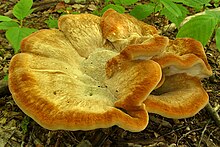Bondarzewia berkeleyi
| Bondarzewia berkeleyi | |
|---|---|

| |
| Scientific classification | |
| Domain: | Eukaryota |
| Kingdom: | Fungi |
| Division: | Basidiomycota |
| Class: | Agaricomycetes |
| Order: | Russulales |
| Family: | Bondarzewiaceae |
| Genus: | Bondarzewia |
| Species: | B. berkeleyi
|
| Binomial name | |
| Bondarzewia berkeleyi | |
| Synonyms | |
| |
Bondarzewia berkeleyi, commonly known as Berkeley's polypore,[1] or stump blossoms,[2] is a species of polypore fungus in the family Russulaceae. It is a parasitic species that causes butt rot in oaks and other hardwood trees. A widespread fungus, it is found in the Old World and North America.
Taxonomy
[edit]Elias Magnus Fries described the species as Polyporus berkeleyi in 1851. It was moved to the genus Bondarzewia in 1941.[3]
Description
[edit]The fan- or shelf-shaped caps grow in overlapping clumps from the bases of trees, each growing to 20–50 centimetres (8–19+1⁄2 in) diameter.[4] They are zoned in various shades of white to pale grey, cream, beige or yellow.[4] The pore surface is white, as is the spore print. The round spores are 7–9 by 6–8 μm and have marked amyloid ridges. The tough white flesh can be up to 3 cm (1+1⁄4 in) thick and has a mild taste, becoming bitter with age.[4] The outer edges that cut easily with a knife are quite tender.
Similar species
[edit]Potential lookalikes include B. occidentalis, Grifola frondosa, Meripilus sumstinei, and Vanderbylia spp.[4]
Distribution and habitat
[edit]The distribution of B. berkeleyi is widespread, occurring in Europe, Asia, Africa, and North America east of the Great Plains (June–October).[5][6][4] While its primary host is oak, it has also been observed on other hardwood species such as maple.[7]
In China it has been recorded from Guangdong and Hunan provinces.[5][8] The fruit bodies appear over July to October in the United States.[1] A survey of host trees in North Carolina found that it almost always grew on oaks, being recorded from the white oak (Quercus alba), scarlet oak (Q. coccinea), southern red oak (Q. falcata), chestnut oak (Q. prinus) and eastern black oak (Q. velutina), as well as bird cherry (Prunus pensylvanica).[9]
Ecology
[edit]Bondarzewia berkeleyi is a parasitic fungus causing butt rot in oaks and other hardwood trees.[10] It causes a white stringy rot in the roots and heartwood of the lower trunk, typically not extending more than 0.9–1.5 m (3–5 ft) upwards. The decay is mainly restricted to the heartwood, and external symptoms might include excessive tapering or flaring at the base of the trunk, cracks, seams, and sap flow. The fungus is known for its rapid growth rate compared to other wood-rotting fungi common on oaks.[11]
While primarily a parasite, B. berkeleyi can also act as a saprophyte, thriving on dead hardwood trees or stumps. The fruiting bodies typically appear on infected trees in summer and fall.[10]
Edibility
[edit]B. berkeleyi is typically considered edible when young and tender, the palatability decreases with age as the flesh becomes tough and bitter.[6] Some sources compare the texture to shoe leather when older,[10] while others suggest that the softer outer edges of young specimens can be consumed.[12] Some field guides list the species as inedible or warn that it may cause gastrointestinal upset or allergic reactions in some individuals.[13][14]
It may be able to be used to strengthen other flavors in dishes, much like tofu. It can also reportedly be used as a meat substitute.[15] Preparation methods often involve parboiling or blanching to remove bitterness, followed by slicing and incorporating into stir-fries or other dishes.
See also
[edit]References
[edit]- ^ a b Bessette A. (2007). Mushrooms of the Southeastern United States. Syracuse University Press. p. 250. ISBN 978-0-8156-3112-5.
- ^ Roody WC (2003). Mushrooms of West Virginia and the Central Appalachians. Lexington, Kentucky: University Press of Kentucky. p. 348. ISBN 0-8131-9039-8.
- ^ Bondartsev A, Singer R (1941). "Zur Systematik der Polyporaceae". Annales Mycologici. 39 (1): 43–65.
- ^ a b c d e Audubon (2023). Mushrooms of North America. Knopf. p. 164. ISBN 978-0-593-31998-7.
- ^ a b Zhishu B, Zheng G, Taihui L (1993). The Macrofungus Flora of China's Guangdong Province. New York, New York: Columbia University Press. p. 153.
- ^ a b Phillips, Roger (2010). Mushrooms and Other Fungi of North America. Buffalo, NY: Firefly Books. p. 297. ISBN 978-1-55407-651-2.
- ^ Gramss, G. (January 1987). "R. L. Gilbertson and L. Ryvarden, North American Polypores. Volume 1: Abortiporus — Lindtneria. 433 S., 209 Abb. Oslo 1986. Fungiflora A/S". Journal of Basic Microbiology. 27 (5): 282. doi:10.1002/jobm.3620270513. ISSN 0233-111X.
- ^ Dai YC, Härkönen M, Niemelä T (2003). "Wood-inhabiting fungi in southern China 1. Polypores from Hunan Province" (PDF). Annales Botanici Fennici: 81–93.
- ^ Grand LF, Vernia CS (2007). "Biogeography and hosts of period wood decay fungi in North Carolina: Species of Abortiporus, Bondarzewia, Grifola, Heterobasidion, Laetiporus, and Meripilus" (PDF). Mycotaxon. 99: 99–102.
- ^ a b c Kuo M, Methven A (2010). 100 Cool Mushrooms. Ann Arbor, Michigan: University of Michigan Press. p. 33. ISBN 978-0-472-03417-8.
- ^ nbrazee (2020-01-22). "Root and Butt Rot caused by Bondarzewia berkeleyi (Berkeley's Polypore)". Center for Agriculture, Food, and the Environment. Retrieved 2024-05-20.
- ^ "Berkeley's Polypore". Missouri Department of Conservation. Retrieved 2024-05-20.
- ^ Arora, David (1986). Mushrooms demystified: a comprehensive guide to the fleshy fungi (Second ed.). Berkeley: Ten Speed Press. ISBN 978-0-89815-170-1.
- ^ Miller Jr., Orson K.; Miller, Hope H. (2006). North American Mushrooms: A Field Guide to Edible and Inedible Fungi. Guilford, CN: FalconGuides. p. 420. ISBN 978-0-7627-3109-1.
- ^ Brill S. (2010). The Wild Vegan Cookbook: A Forager's Culinary Guide (in the Field Or in the Supermarket) to Preparing and Savoring Wild (and Not So Wild) Natural Foods. Houghton Mifflin Harcourt. p. 199. ISBN 9781558327214.
External links
[edit]- Bondarzewia berkeleyi in Index Fungorum
 Media related to Bondarzewia berkeleyi at Wikimedia Commons
Media related to Bondarzewia berkeleyi at Wikimedia Commons
